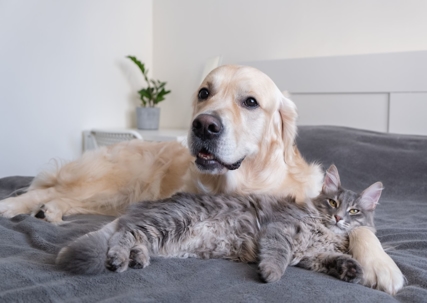Moving to a new home can be an exciting experience, but it can also become stressful for pets who have trouble adapting to their new environment. Even housebroken dogs and cats that use the litter box daily may have accidents when confronted with unfamiliar surroundings. As such, it’s essential to take proactive steps in planning so you and your furry friends can avoid these unwanted incidents during and after your move.
This blog post will provide tips on how pet owners can prepare themselves – and their pets – for the transition into a new home.
Have your pet get familiar with their crate before your move.
Moving with cats or dogs can be stressful, and it can take a while for cats and dogs to adjust, particularly cats. To help ease the transition, acclimating your pet to their travel crate before the move is strongly recommended. Familiarizing them with their travel carrier ahead of time can make the experience of traveling in the crate a lot less stressful.
Additionally, setting your pet up in their new home by leaving their familiar crate in a room they will regularly occupy ahead of time can reduce stress levels. Your pet will also know where to go when they’re overwhelmed or just want some peace and quiet – there's nothing cats or dogs love more than their own space! This simple step can help ensure that cats are litterbox-trained quickly and that housebroken dogs continue to follow the rules of no accidents, even in the chaos of a move.
Plan how your pet will "potty" during a long-distance move.
Moving long-distance with a pet can be challenging. We have some separate tips for cats and dogs.
Tips for Dogs:
- Before your move, get your dog acclimated to using the bathroom on the type of surface they’ll encounter while traveling so that they feel comfortable throughout the journey. If there isn't a grassy patch nearby, you need to know that your dog will be comfortable with going potty on dirt, asphalt, etc., if necessary.
- Plan for regular potty breaks every couple of hours or so to prevent mishaps from happening in the car.
Tips for Cats
- Provide a litter box for your cat in their crate. You will need a large crate to make this work. Again, this is only when traveling for long distances, as cats will avoid using the bathroom inside their crate for as long as possible.
It's also a good idea to line the bottom of your pet's crate with disposable pee pads or something else that can absorb an accident if your pet gets over-anxious.
Introduce your pet to their new environment little by little, showing them where to "potty" before anything else.
Moving can be a stressful time for both you and your pet, but being prepared can help make the transition smoother. To help set your dogs and cats up for success, start by introducing your pet to their new environment little by little and showing them right away where they should go potty before anything else. Dogs should be taken out to the backyard on a leash, while cats should be shown where their “permanent” litterbox is.
Ensure your pet has easy access to their water bowl and bedding so they can find comfort in each.
Moving can be a difficult process for any pet, so it's important to make sure your furry friends have access to all their essentials - like their food and water bowls, litterbox, and bedding. Because these items feel and smell familiar, your pet will start to recognize this new environment as their comfort zone. This helps reduce stress and confusion during the move (and after!). So be sure to unpack those important items first so that your pet has a soft landing in your new home.
If a pet has an accident, clean it up with products specifically designed for pet messes.
As a pet owner, you may not anticipate the potential potty issues that can arise following a move. While most housebroken pets and litterbox-trained cats can handle a move fairly well, there's always the chance they could have an accident in the new environment. If an accident does occur, use cleaning products specifically designed for pet messes to clean it up.
Not only will these products ensure proper cleanup and odor removal, but they will also help discourage your pet from considering certain areas as acceptable potty spots.
Positively reinforce desired behavior by rewarding them with treats, praise, etc. when they go potty where they’re supposed to.
This tip is especially important for dogs, but it can also apply to some cats. Positive reinforcement is key to ensuring a successful transition when moving to a new home. Positive reinforcement can include rewarding your pup with treats, verbal praise, or physical affection when they go potty where they’re supposed to. This will help them become more comfortable in the new environment, understand their designated spot to do their business, and continue being housebroken.
In Conclusion
Moving with pets can present challenges that most pet owners don’t anticipate. With the proper preparation and preventive measures, your pet can make a successful transition to their new home, and you can save yourself from some added stress during your move.
Planning a move? Call (615) 240-2811 to hire our experienced and professional team at True Friends Moving Company, and check out our blog for more moving tips and tricks!

